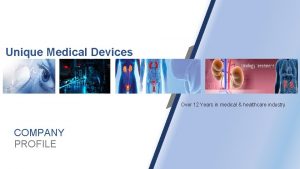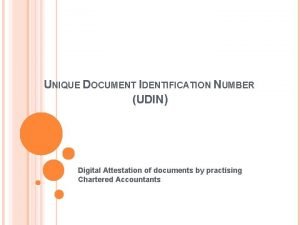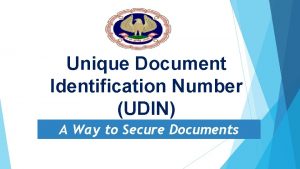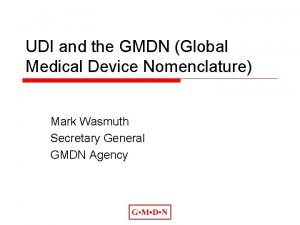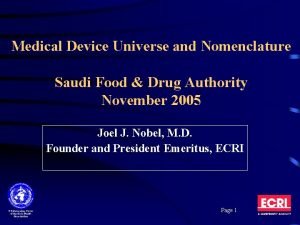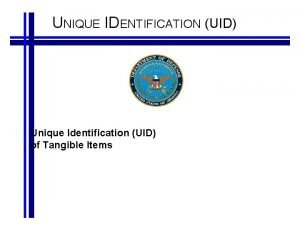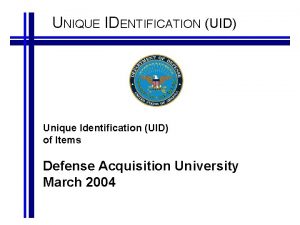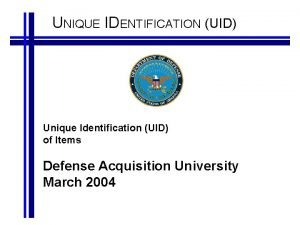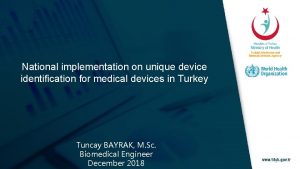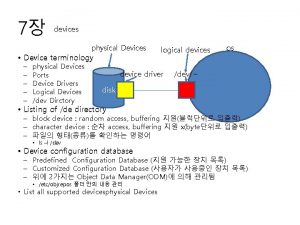Unique Device Identification UDI System for Medical Devices














- Slides: 14

Unique Device Identification (UDI) System for Medical Devices http: //www. ghtf. org/ahwg-proposed. html Dr Larry Kelly Therapeutic Goods Administration Australia WHO Informal Consultation on Nomenclatures for Medical Devices – Geneva – 23 -24 March 2011

The objective of a UDI is to enhance patient safety by: • Facilitating traceability of devices by providing a single globally accepted source for identification of medical devices through distribution and use. • Improving the identification of devices involved in adverse events leading to more rapid resolution of problems. • Facilitating field service corrective actions. It is anticipated that a UDI System may facilitate the reduction of medical errors by simplifying integration of information on device use into medical records. WHO Informal Consultation on Nomenclatures for Medical Devices – Geneva – 23 -24 March 2011

Implementation issues of a global UDI The true benefit, in terms of patient safety , will only be achieved if all stakeholders (from manufacturer through to healthcare providers) use the globally harmonized UDI systems. Local deviations (regional or country) will have a negative impact on the main objective of enhancing patient safety. The risk that the entire UDI concept would become inconsistent and unmanageable is very high. Therefore the GHTF strongly recommends avoiding such deviations. WHO Informal Consultation on Nomenclatures for Medical Devices – Geneva – 23 -24 March 2011

The GHTF guidance aims to avoid prescriptive countryspecific requirements regarding the core elements of the UDI System by developing common guidance to: – Create, use and maintain a unique “Device Identifier” – Develop and apply a “UDI Carrier” – Describe a ‘UDI Database” with a defined list of Data Elements. WHO Informal Consultation on Nomenclatures for Medical Devices – Geneva – 23 -24 March 2011

UDI The UDI is a series of numeric or alphanumeric characters that is created through a coding system. It allows the unambiguous identification of a specific product on the market and represents the “access key” to device related information stored in the UDI Database. The UDI comprises the Device Identifier and Production Identifier. Note: The word “Unique” does not imply serialisation of every single device, e. g. those devices marketed in lots and batches. WHO Informal Consultation on Nomenclatures for Medical Devices – Geneva – 23 -24 March 2011

UDI System Explanation of Terms The framework for the production of a Unique Device Identifier (UDI), the application of the UDI on the label or directly on product, and the storage of the UDI and additional device related information in a UDI Database. UDI – Device Identifier (static) Is a unique numeric or alphanumeric code specific to a medical device and that is also used as the “access key” to information stored in a UDI Database. UDI – Production Identifier (dynamic) Is a numeric or alphanumeric code providing information reflecting how the device is controlled. The different types of Production Identifier(s) can include any combination of serial number, lot/batch number, manufacturing or expiration date. UDI Carrier is the means to convey the UDI by using automatic identification and data capture (AIDC) and if applicable human readable information (HRI). UDI Database (UDID) The UDID is an organized collection of information associated with medical device identification and labelling. WHO Informal Consultation on Nomenclatures for Medical Devices – Geneva – 23 -24 March 2011

Guidance for the UDI System • A UDI System for medical devices shall consist of a unique identification code using a globally accepted standard format. In order to accommodate most methods of labelling, marking, and identifying products, UDI Carrier should be technology neutral. National or regional regulatory requirements shall not restrict methods of AIDC as this will hinder the establishment of a global UDI System. • Internationally accepted coding systems such as GS 1 and HIBCC, meet the criteria of the UDI and manufacturers shall be permitted to choose which system to use. WHO Informal Consultation on Nomenclatures for Medical Devices – Geneva – 23 -24 March 2011

Guidance for the UDI System • The manufacturer shall be responsible for creating and maintaining the uniqueness of its medical device UDI throughout all jurisdictions world-wide. All along the supply chain the UDI created by manufacturer shall not be altered. • The UDI Carrier shall be on the label of the device or on the device itself. • The manufacturer is responsible for maintaining the accessibility of their UDI and the related information (UDI Database) • The National/Regional regulation for UDI System shall include a robust process for evaluation and adjudicating applications for UDI exemptions. WHO Informal Consultation on Nomenclatures for Medical Devices – Geneva – 23 -24 March 2011

Guidance for the UDI System • The assignment of a UDI to a device shall follow international medical device identification standards allocation rules. A significant change to device characteristics requires that a new UDI must be allocated to the product. • Reprocessors of single use devices (SUD) shall create a new UDI. All requirements shall apply to the reprocessed SUD. The processor is responsible for ensuring that the reprocessed device cannot be confused with the original SUD. • Remanufacturers shall create a new UDI. All requirements shall apply to the remanufactured device. In addition the remanufacturer shall retain a record of the original manufacturer’s UDI. WHO Informal Consultation on Nomenclatures for Medical Devices – Geneva – 23 -24 March 2011

Guidance for the UDI System • The Device Identifier and the Production Identifier must be individually identifiable. • The UDI should be human readable and encoded in an AIDC format. • If there are significant space constraints limiting the use of both forms on the label, the AIDC format shall be favoured. However, certain environments or use situations, such as home care, may warrant the use of human readable over AIDC. • In case of RFID, human readable information and bar code shall also be provided. WHO Informal Consultation on Nomenclatures for Medical Devices – Geneva – 23 -24 March 2011

Device Identifier • Manufacturer information • Device information • Special characteristics (sterile) and properties (latex), • Production information. WHO Informal Consultation on Nomenclatures for Medical Devices – Geneva – 23 -24 March 2011

Production Identifier • The Production Identifier specifies the particular production unit i. e. Serial number, and/or batch, or lot number. If the label has an expiry date, it shall be part of the UDI Production Identifier. If the device does not have a serial and/or batch or lot number, the manufacture date shall be used. • The different types of Production Identifiers included in the UDI will depend on the risks associated with the distribution and use of the device. Based on this risk assessment certain devices do not require Production Identifiers as part of the UDI. WHO Informal Consultation on Nomenclatures for Medical Devices – Geneva – 23 -24 March 2011

UDI Database The wording UDI Database (UDID) refers to a global conceptual Database which in practice may consist of a single internationally accessible database or a network of Regional UDI Databases which should be able to communicate with each other. The manufacturer shall be responsible for submitting and maintaining the identifying information and other device data elements in the UDID. All UDID data elements are required, unless indicated otherwise. “If applicable” means the information shall be in the UDID when it appears on the label. WHO Informal Consultation on Nomenclatures for Medical Devices – Geneva – 23 -24 March 2011

Acknowledgements: GHTF Ad Hoc Working Group L Selles (Chair) C Tarrajat J Crowley L Tao M Kreuzer T Werthwi Y Liang C Rose J Elkin J Secunda M Neumann R Munoz V Zeinar H Ishikawa http: //www. ghtf. org/ahwg-proposed. html WHO Informal Consultation on Nomenclatures for Medical Devices – Geneva – 23 -24 March 2011
